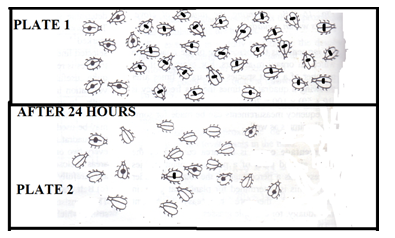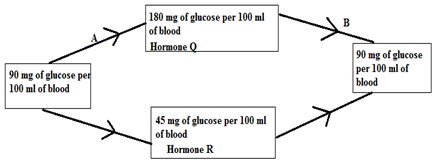Instructions to Candidates:
- Candidates should answer the questions in English.
- State FOUR environmental problems that can be solved by studying biology. (4 marks)
- Aerobic break down of glucose yields 2880 kJ of energy whereas anaerobic breakdown yields 150 kJ. Give an explanation to account for this difference. (4 marks)
- How many of 20 micrometres animal cells would fit in a 1cm long line? (2marks)
- State the function of the following apparatus;
- Specimen bottle . (1 mark)
- Bait trap. (1 mark)
- Name the causative agents of the following diseases:
- Cholera…………………………………………………………………………(1 mark)
- Malaria …………………….…………………………………………………..(1 mark)
- Explain why young onion root tip is ideal for examining the stages of mitosis. (2 marks)
- The table below shows the concentration of some ions in pond water and in the cell sap of some aquatic plant growing in the pond
Ions Concentration in pond water(parts per million) Concentration in cell sap(parts per million) Sodium PotassiumCalciumChloride50
2
1.5
18030
150
1
200- With a reason name the process by which each of the following ions could have been taken up by this plant
- Sodium ……………………………........................( 2marks) Reason..................................................................
- Potassium …………………………………………….(2marks)
Reason....................................................................
-
- Which ion would cease to be absorbed if the plant was treated with a metabolic poison? .(1mark)
- Give a reason for your answer (1mark)
- With a reason name the process by which each of the following ions could have been taken up by this plant
- The photograph illustrates an organism found in aquatic habitat.
- Give the type of the plant
- Describe three adaptation of the organism to its habitat. (3 marks)
- A student smeared the abdomen of a locust with Vaseline.
- What were the likely results after ten minutes? (1 mark)
- Account for the results obtained above. (2marks)
- What is the significance of photolysis? (2 marks)
- The following table shows the volume of gases carried by 100cm3 of blood.
Gas Blood entering lungs Blood leaving lungs Nitrogen 0.9cm3 0.9cm3 Oxygen 10.6cm3 19.0cm3 Carbon(IV)Oxide 58.0cm3 50.0cm3 - Which blood has a higher content of carbon (IV) oxide? (1 mark)
- Explain the difference in the content of oxygen and carbon (IV) oxide in blood entering the lungs and that leaving the lungs. (2 marks)
- Use the illustration below to answer questions.
- Identify the method of population estimation shown above. (1 mark)
- Estimate the population of the beetles. (3 marks)
- State one limitation of this method. (1 mark)
- An investigation was carried between 1994 and 2003 to study the changes of fish population in a certain small lake. Four species of fish A,B, C and D were found to live in this lake.In 1995,A factory was built near the lake raising temperatures from 25°C to 30°C.In 1997,Sewage and industrial waste was diverted into the lake. The population of fish during the period of investigation is shown in the table below.
Explain two factors that could have brought the changes in the fish populations.(2 marks)Fish species 1994 1996 1998 2000 2001 2002 2003 A 6102 223 20 106 660 4071 7512 B 208 30 11 22 63 311 405 C 36 100 0 0 0 0 0 D 4521 272 23 23 29 400 617 - State the functions of the following parts of a light microscope.
Coarse adjustment knob. (1 mark) - Use the diagram below to answer questions that follow.
- Name the feedback mechanism labeled B. (1 mark)
- Identify Hormone R……………………………………………………………..…. (1 mark)
- Name three food substances acquired by herbivores feeding on green sprouting grass exposed to maximum sunlight during the day. (3 marks)
- A certain animal has no incisors, no canines,6 premolars and 6 molars in its upper jaw. In the lower jaw there are 6 incisors,2 canines,6 premolars and 6 molars.
- Write its dental formula. (2mark)
- Identify the mode of nutrition of the organism. (1 mark)
- Give a reason for your answer in (b) above. (1 mark)
-
- Identify the following:
- The structure that prevents backflow of blood when pressure in the ventricles fall. (1mark)
- The vessel from which coronary artery branches (1mark)
- The size of the heart is closely related to the size of the body of the organism. Generally the heart weighs 0.59 percent of the total body weight. Calculate the weight of a healthy adult if his heart weighs 0.4838Kg (2marks)
- Identify the following:
- A small mammal has ears that are usually pink, but on a day when the environmental temperature is low the ears appear pale pink. Explain this observation (3marks)
-
- State the function of the following during cell division
- Spindle fibres (1mark)
- Centrioles (1mark)
- What is the significance of protandry and protogyny structural features in flowering plants. (2marks)
- State the function of the following during cell division
- Distinguish between the Cytology and entomology. (2 mark)
- Give the roles of the following hormones in males
- Follicle stimulating hormone. (1 mark)
- Luteinizing hormone. (1 mark)
- Describe how the granum is adapted to its photosynthetic function. (2 marks)
- Below is a photograph of a fruit.
- State the agent of dispersal of the fruit. (1 mark)
- Give a reason for your answer in (a) above. (1 mark)
-
- State two advantages of metamorphosis to the life of insects (2marks)
- Name two harmful effects of insects (2marks)
- What is the function of coleoptile in germinating maize grain? (1mark)
-
- Define the term monohybrid inheritance (1mark)
- Differentiate between genotype and phenotype (2marks)
- In some fruit flies there exist two varieties; one with red eyes and another with white eyes. In a population of these organisms, the red eyed greatly outnumber the white eyed.
A white eyed female was crossed with a red eyed male. All the females from the cross were red eyed while all the males were white eyed. Using the given information, answer the following questions;
Which gene is- Dominant ..................................................................................................................(1mark)
- Recessive....................................................................................................................(1mark)

MARKING SCHEME
-
- Drought;
-
Conservation of resources;
-
Pollution;
-
Food shortage;
-
Poor health; 4
- Drought;
-
In aerobic respiration glucose is completely oxidized; releasing large amount of energy; while in anaerobic respiration, glucose is partially oxidized; releasing less energy
- 1 × 10 × 100 = 500 cells
20 -
- storage of the collected specimen(s);
- Attract and trap rodents;
-
- Vibrio chlolerae;
- Plasmodium species;
-
- Cells are large;
- Cells are actively dividing;
-
-
- Diffusion; movement of solute molecules from high concentration to low concentration;
- Active transport; movement of solute molecules from low concentration to high concentration / movement of solute molecules against a concentration gradient;
-
- Potassium ion;
- Metabolic poison stops respiration/energy production which is needed for active absorption of potassium ions;
-
-
- hydrophyte; (1 mark)
-
- Broad leaves provide large surface area for loss of excess water;
- Flowers are raised above the water to allow pollination;
- Leaves have chloroplasts that photosynthesize under low light intensity;
-
- suffocation;
- Vaseline blocks the spiracles; no inhalation;
-
- formation of ATP;
- Production of hydrogen atoms;
-
- blood entering lungs;
- Blood entering the lungs has released oxygen to tissues and carbon (iv) oxide formed is added; blood leaving lungs has received oxygen and released carbon (iv) oxide;
-
- capture recapture method;
- P = FM X SC
MR ; 35 X 20 = 100
7 -
- Beetles may migrate;
- Released beetles may not mix freely due to mark;
- Beetles may move in;
- Released beetles may not have enough time to mix; any 2
-
- hot water killed the fish;
- Organic matter in sewage is decomposed;
- oxygen is depleted causing suffocation and death;
-
- lowers the body tube through longer distances to bring the image into focus;
- concentrates light onto the stage;
-
- negative;
- Glucagon;
- Starch/carbohydrates/glucose; fatty acids; amino acids; vitamins; any 3
-
- i 0/3 c0/1 pm3/3 m3/3;
- Herbivorous;
-
- Absence of upper incisors;
- Absence of upper canines;
-
-
- Semilunar valves;
- Aorta;
- 0.4838 × 100 = 82kg (2mks)
0.59
-
- Constriction/ narrowing / shunt effect of arteriole; less blood flow to capillaries reduces heat loss; through radiation/conduction/convection;
-
-
- The chromosomes attach themselves through centromere to facilitate their division;
- Formation of spindle fibres;
- Facilitates cross pollination; resulting in variation/ hybrid vigour
-
- cytology is the study of cells while entomology is the study of insects;
-
- stimulates synthesis of sperms;
- stimulates the interstitial cells to release male hormones;
- Has green pigment chlorophyll; that traps light energy;
-
- Animal;
- Hook like structures that stick onto fur/hair of animals;
-
-
- Enables them to survive unfavourable weather conditions through the pupa stage
- Random dispersal of various stages prevents overcrowding competition
-
- pests eg weevils and stalk borers destroy food crops/products;
- termites destroy timber for construction
- vectors eg mosquitoes and tsetse fly transmit disease causing microorganisms
- houseflies contaminate food with dirt and disease pathogens for cholera, typhoid etc
-
- Protects the delicate plumule from mechanical damage as it emerges from the ground
-
- Transmission of one pair of contrasting characteritics
-
- Genotype-genetic constitution of an organism
- Phenotype-physical /outward appearance of an organism
-
- Dominant - Red eyes
- Recessive - White eyes
Join our whatsapp group for latest updates
Tap Here to Download for 50/-
Get on WhatsApp for 50/-
Download Biology Paper 1 Questions and Answers - Form 4 Term 1 Opener Exams 2023.
Tap Here to Download for 50/-
Get on WhatsApp for 50/-
Why download?
- ✔ To read offline at any time.
- ✔ To Print at your convenience
- ✔ Share Easily with Friends / Students





